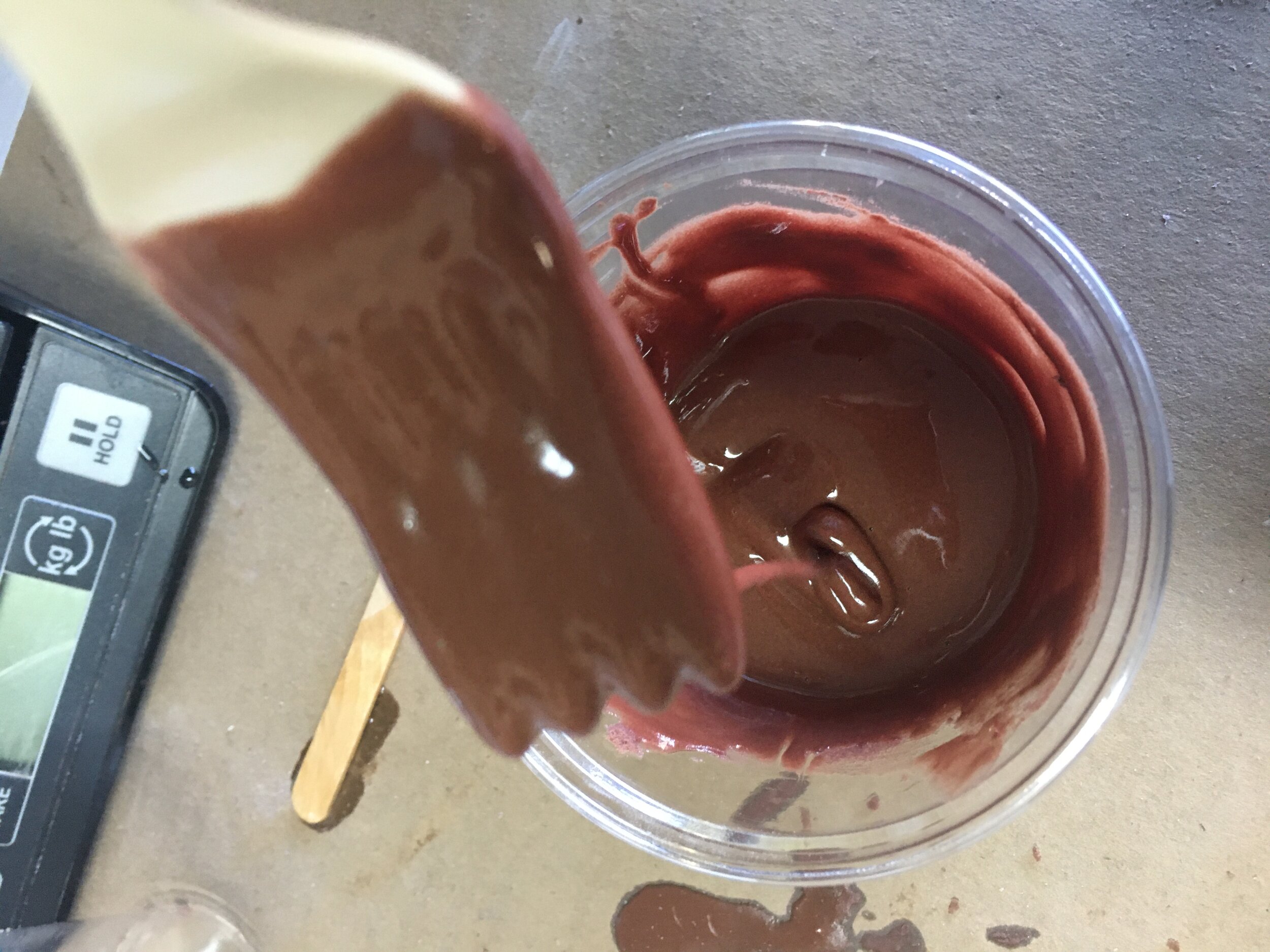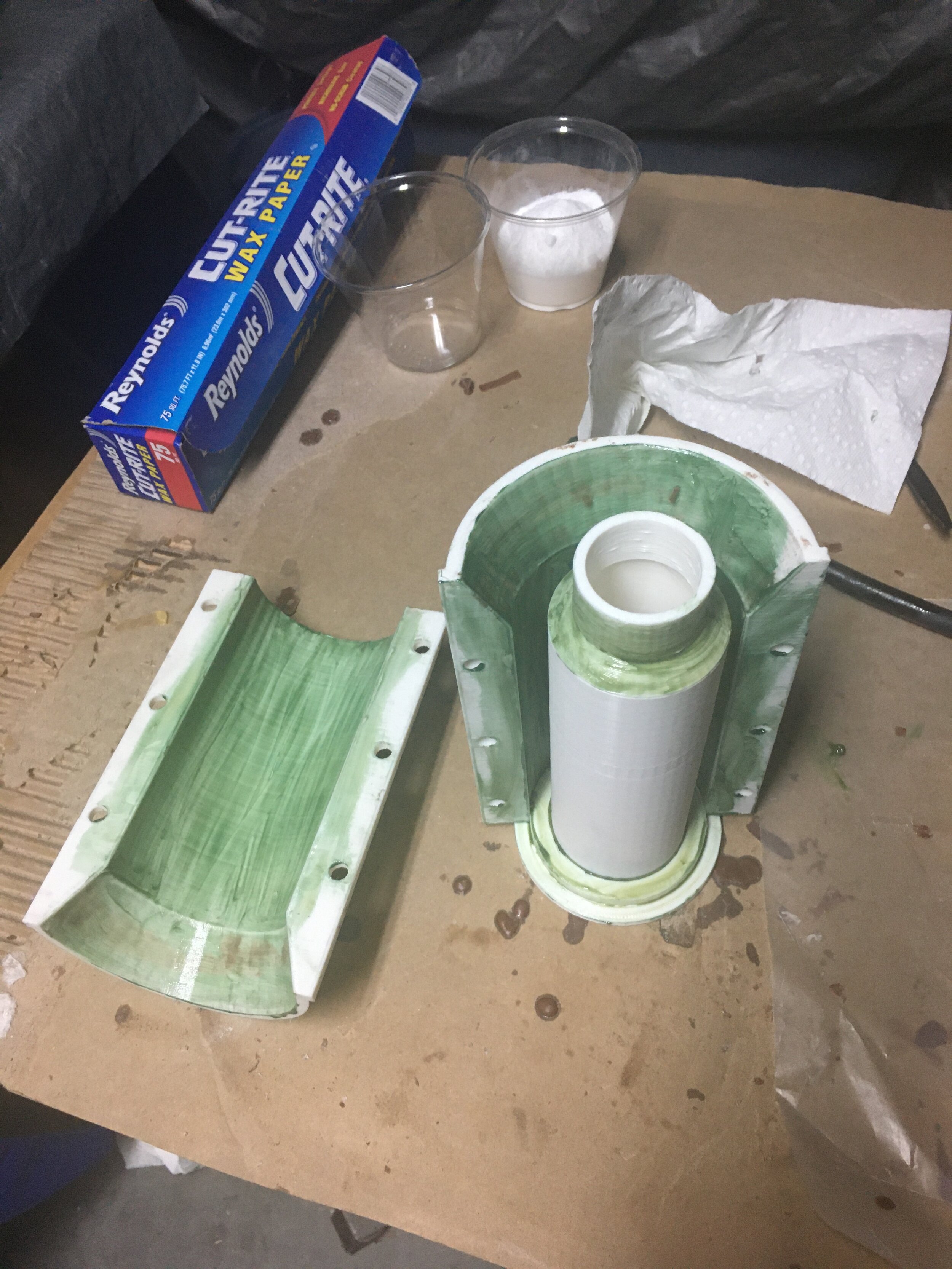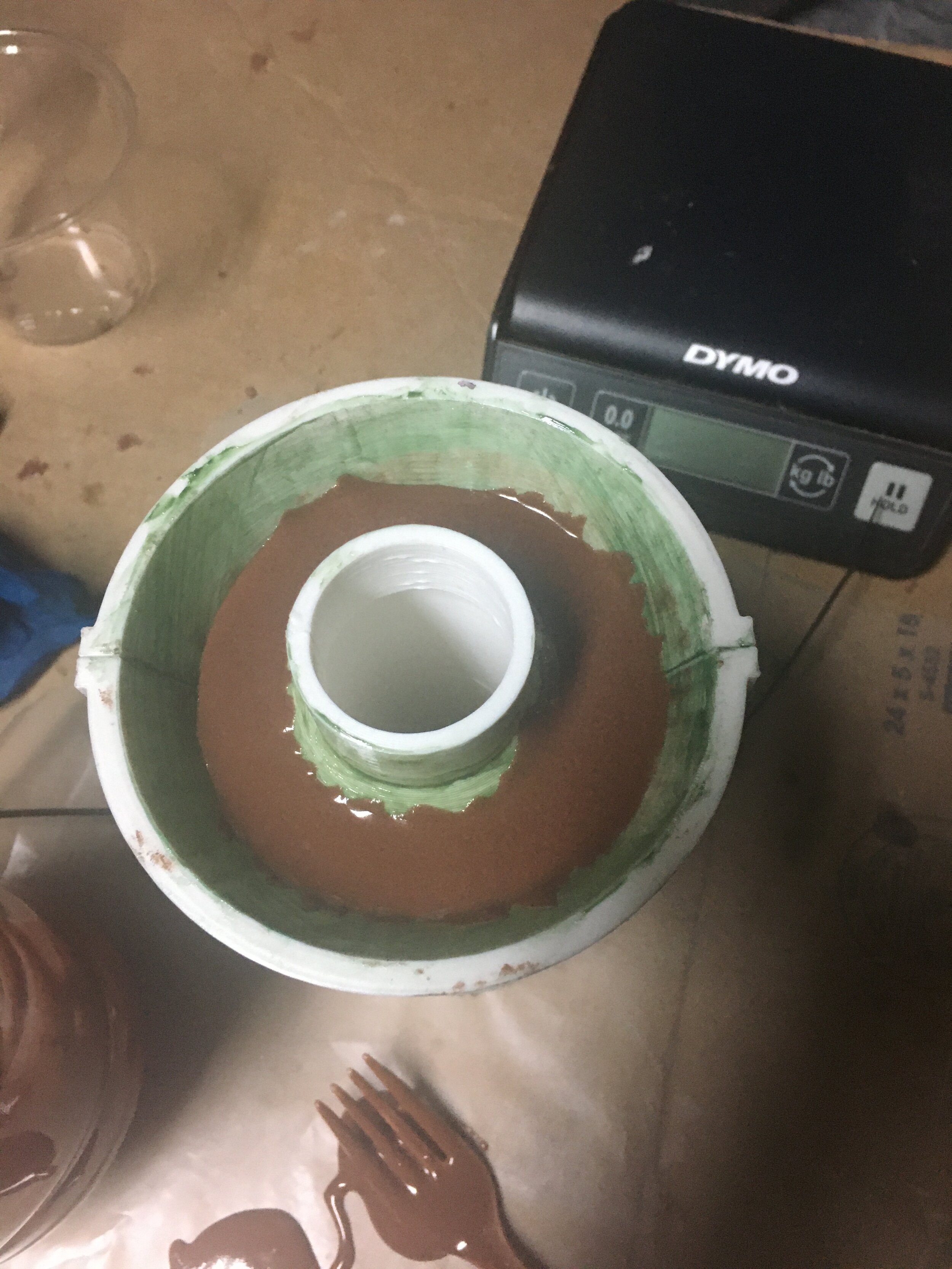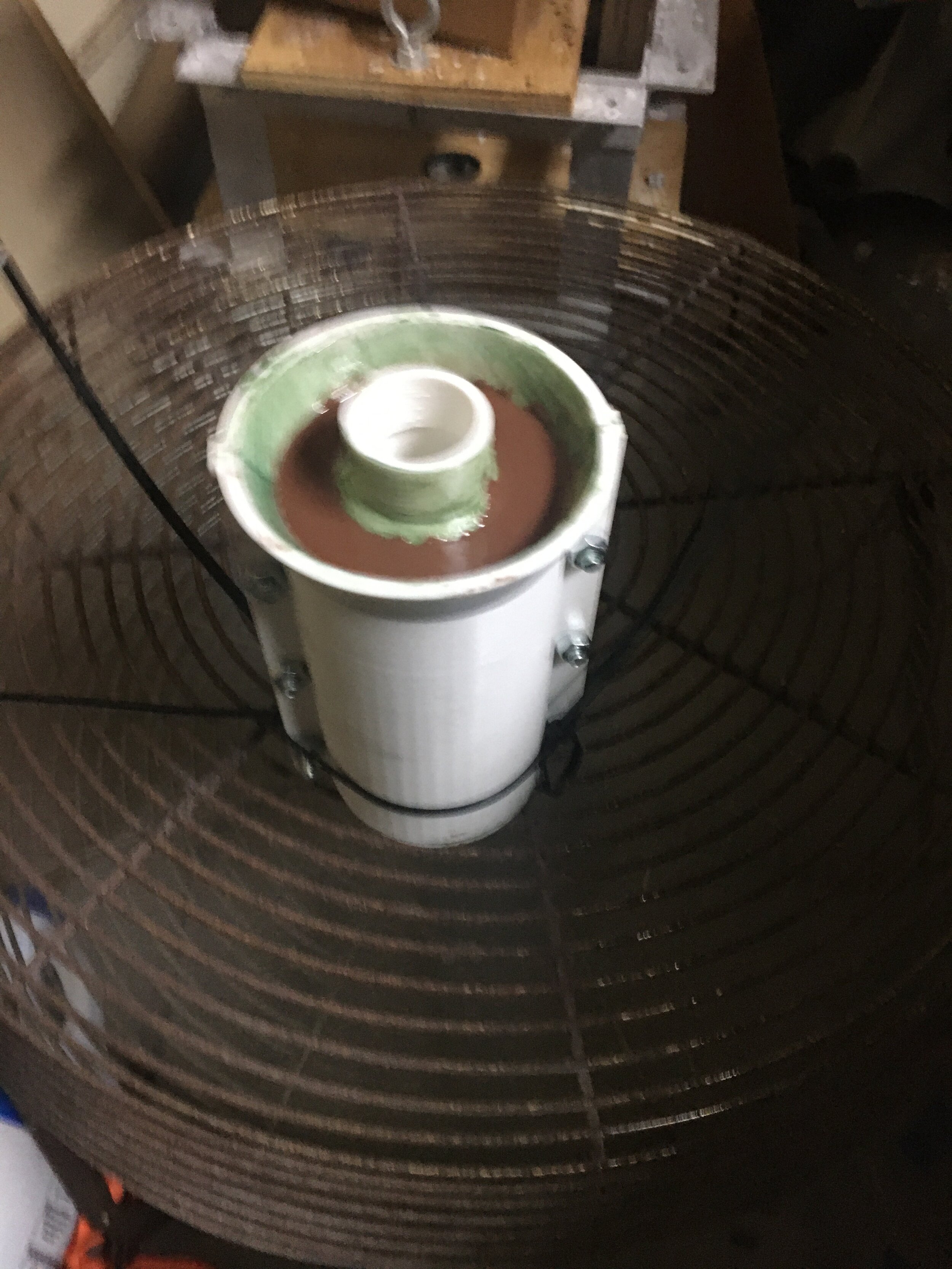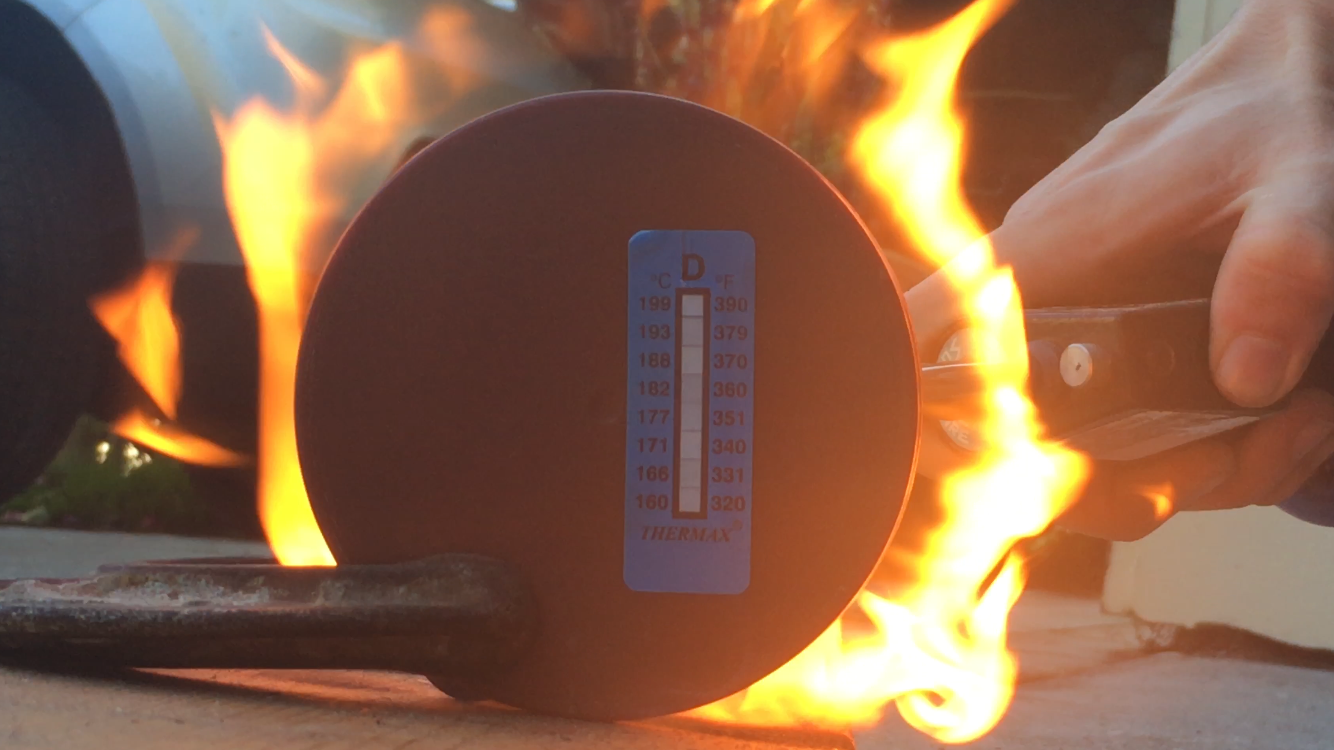CHAMBERSAFE
CHAMBERSAFE was developed by Half Cat Rocketry with the goal of creating a low-cost, non-hazardous ablative material that could be cast into a mold to create combustion chamber liners for amateur liquid rocket engines. It is a mixture of laminating epoxy, phenolic microballoons, and sodium bicarbonate (baking soda), and falls into a category of materials known as syntactic foams.
The name is a spectacular backronym that stands for Castable High-temperature Ablative MicroBalloon Epoxy Resin Syntactic Autoextinguishing Foam Experimental liner material.
Ablative materials work by forming a char layer at the surface, which is continually being stripped away by high-velocity hot gas and replaced as the material underneath is exposed to the extreme heat. The gases formed by the slow burning of the surface carry thermal energy away from the rest of the material.
The epoxy serves as a binder and gives the liner its structural integrity, although it is not intended to be load-bearing as in a floating injector design. The epoxy also contributes to the char layer. Although the char characteristics of common laminating epoxy are less ideal than those of phenolic or novolac resins, it is much easier to obtain, much less expensive, and much less unpleasant to work with.
The phenolic microballoons also help create a char layer as they pyrolyze on the surface of the liner at about 1000°C. As they are mostly nitrogen by volume, they significantly reduce the bulk density of the mix, and serve as an effective insulator to slow the transfer of heat through the liner and into the combustion chamber casing.
The sodium bicarbonate releases water vapor and carbon dioxide as it thermally decomposes. This produces a film-cooling effect that helps carry heat away from the wall of the liner, and may contribute to lowering the heat flux at the nozzle. The release of H2O and CO2 also causes the material to self-extinguish in about 6 seconds after the removal of a heat source in ambient atmospheric conditions, although residual oxidizer vapor entering the combustion chamber can result in a prolonged fire, as was seen in Static Fire 3 of Half Cat.
One of the most important characteristics of CHAMBERSAFE is that it deposits a relatively thick layer of soot, which readily adheres to the surface of the nozzle. This mixture of charred epoxy, pyrolyzed phenolic, and sodium carbonate (Na2CO3) forms a thermal barrier coating that significantly reduces heat transfer into the nozzle. The result is that a copper nozzle can be used for burn durations far exceeding what would be possible for a traditional heatsink nozzle. The copper nozzle used in Half Cat has survived firings of up to 8 seconds duration without any signs of melting or erosion of the throat. Upon removing the soot layer, the fine scratches left by the file used to radius the throat corners were still visible, even after four consecutive firings on the same nozzle. This is one advantage of using sodium bicarbonate as the fire retardant ingredient; it produces much less abrasive decomposition products than Alumina Trihydrate, and a higher percentage of its molar mass (37%) contributes to film cooling, compared to only about 20% for Gypsum (CaSO4*2H2O).
Performance Data
In Half Cat static fires 4 & 5, an inert gas purge was installed to expel the remaining nitrous vapor from the tank, to prevent sustained burning of the liner and allow the regression of the ablative to be accurately measured. In both tests the exterior temperature of the combustion chamber casing remained below 116 °C, however the inert gas purge may have reduced the heat soak into the casing by cooling the inside of the liner after the burn. The actual maximum temperature of the chamber casing is not known, as 116 °C was the lowest value that could be detected by the temperature indicating stickers installed for those tests. The thickness of the liner was 0.34 inches (8.64mm), and the combustion chamber casing was 1/8-inch-thick (3.18mm) 6061 aluminum.
The maximum measured regression of the CHAMBERSAFE was 0.142 inches (3.6mm). If this regression is assumed to have taken place over the entire duration of the thrust curve including the tail-off, the average regression rate is approximately 0.018 in/s (0.46mm/s). This is directly comparable to the performance of paper phenolic liners, which have been observed to regress at approximately 0.017 in/s (0.43mm/s) in other amateur nitrous/alcohol bipropellant engines. Data from Georgia Tech’s Darcy 1 and Darcy 2 showed a regression rate of about 0.020 in/s, which matches well with past observations.
If the regression is assumed to have taken place only during the first 5 seconds of burn before thrust and chamber pressure began to significantly decline, the regression rate is found to be approximately 0.028 in/s (0.71mm/s).
The regression was greatest at an axial position in the chamber corresponding with where the propellant streams were observed to mix during cold flow testing of the injector. The liner showed no measurable regression at the head end of the chamber, above the zone of combustion.
Table 1: Summary of CHAMBERSAFE Characteristics
Darcy 2, which ran at a similar OF ratio, showed a regression rate of 0.020 in/s, indicating that the lower bound is more realistic.
Composition
63.3% Laminating Epoxy (including both resin and hardener)
31.7% Sodium Bicarbonate (baking soda)
5.0% Phenolic Microballoons
The above percentages are given by mass. Note that due to the difference in densities, the mixture is roughly 20% phenolic microballons by volume.
A note on epoxy: not all laminating resins will have the same properties. CHAMBERSAFE was developed using EpoxyTek 2:1 General Purpose Epoxy with Medium hardener. Other epoxies will likely perform similarly, but have not been tested by Half Cat Rocketry. If you make and test a variant of CHAMBERSAFE using a different type of resin, we’d love to hear about it! You can reach us by emailing contact@halfcatrocketry.com.
Preparation
Begin by preparing the mold that will create the desired geometry for your combustion chamber. Apply a thin, even coating of grease to all surfaces that will be in contact with the CHAMBERSAFE, and assemble the mold as required.
Weigh out each of the ingredients in separate cups according to the proportions given above.
Thoroughly mix the epoxy resin and hardener according to the directions, in a container large enough for the volume of CHAMBERSAFE you are making. Avoid excessively whipping air into the epoxy, but do not be concerned if there are many small bubbles, as they will escape later.
Pour the sodium bicarbonate into the mixed epoxy, and stir until it is evenly distributed.
Scoop in about half of the phenolic microballons, and fold them into the mixture. Once you have eliminated any dry clumps of powder, add the second half of the microballoons. A disposable fork is recommended for this step, as it helps break up the microballoons.
When the mixture is fully homogeneous, it is ready to pour into the mold. It should be a thick liquid with a rich brown color and a slightly grainy texture, somewhat reminiscent of chocolate cake batter.
When casting CHAMBERSAFE into a mold, pour it slowly so that it leaves the mixing container in a thin stream. This will help remove any trapped air bubbles. Pour only into one side of the mold and allow the mixture to flow around to the other side, to reduce the chances of voids being formed.
The epoxy releases a significant amount of heat as it cures. If using a 3D printed mold, it is strongly recommended to print with a high infill percentage and at least four perimeters. In addition, cooling may be required to prevent deformation, depending on the thickness of the mold and the quantity of CHAMBERSAFE. This may be accomplished by placing the mold on the grate of a shop fan pointing towards the ceiling, and securing it in place using zip ties. This method also has the advantage of vibrating the mixture to further remove air bubbles.
Design Considerations
When designing an engine to use a CHAMBERSAFE liner, it is recommended to conservatively assume a regression rate value of 0.025 in/s (0.64 mm/s). CHAMBERSAFE was tested in 2Cat/3 in 2021 and 2022, with a burn time of approximately 6 seconds. The regression rate data was similar to Half Cat and Darcy.
The regression rate may vary significantly from one engine to another, depending on several factors outlined below.
O/F Ratio: Half Cat has an O/F ratio of approximately 3.57, resulting in a relatively low combustion chamber temperature. Operating at a higher O/F ratio and chamber temperature will likely increase the regression rate.
Chamber Pressure: Half Cat operates at a peak chamber pressure of approximately 425 PSI, and the 2Cat/3 engine is designed for 350 PSI. CHAMBERSAFE may regress faster at higher chamber pressures, and above 500 PSI there is a risk of the phenolic microballoons collapsing.
Injector Design: Both Half Cat and 2Cat/3 inject the oxidizer at the center of the combustion chamber, with a spray of fuel surrounding it on all sides. This reduces contact between free oxidizer and the wall of the chamber, to prevent the ablative from being consumed as fuel. Injector designs that allow oxidizer to reach the chamber walls would likely see a much higher regression rate.
Burn Duration: longer-duration burns (>8 seconds) may lead to non-linearity in the regression rate. As heat soaks into the liner, raising the temperature of the epoxy binder farther from the surface could degrade its mechanical properties, allowing the liner to be more quickly stripped away by the hot, high-velocity combustion gas.
Future Developments
While CHAMBERSAFE in its current form has proven to be usable as an ablative liner for liquid rocket engines, research and development is still ongoing. The percentages of sodium bicarbonate and phenolic microballons are limited primarily by the pourability of the mixture. As such, a new formulation of CHAMBERSAFE using low-viscosity epoxy resin may allow the mixture to remain pourable with much higher solids loading, in order to obtain greater film cooling performance while lowering both the density and regression rate.
